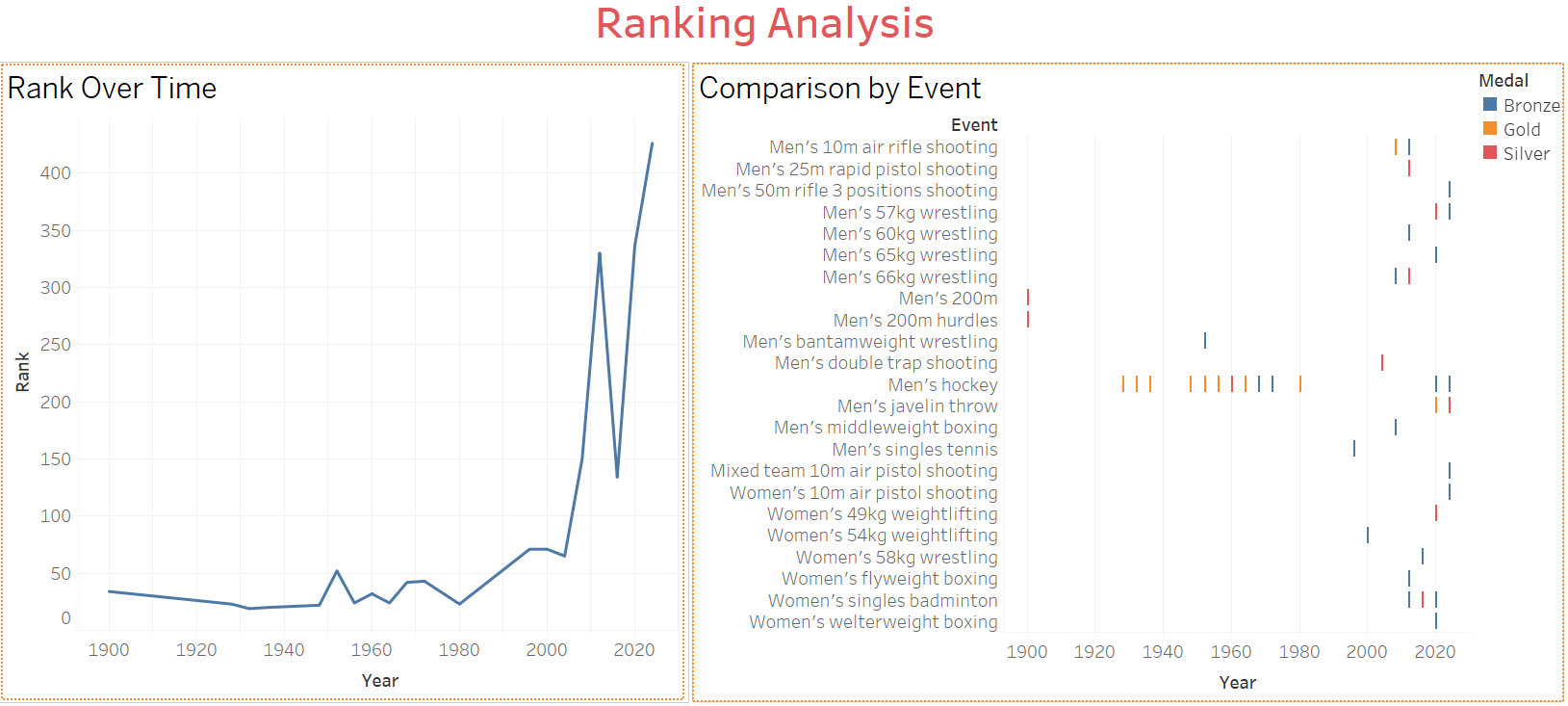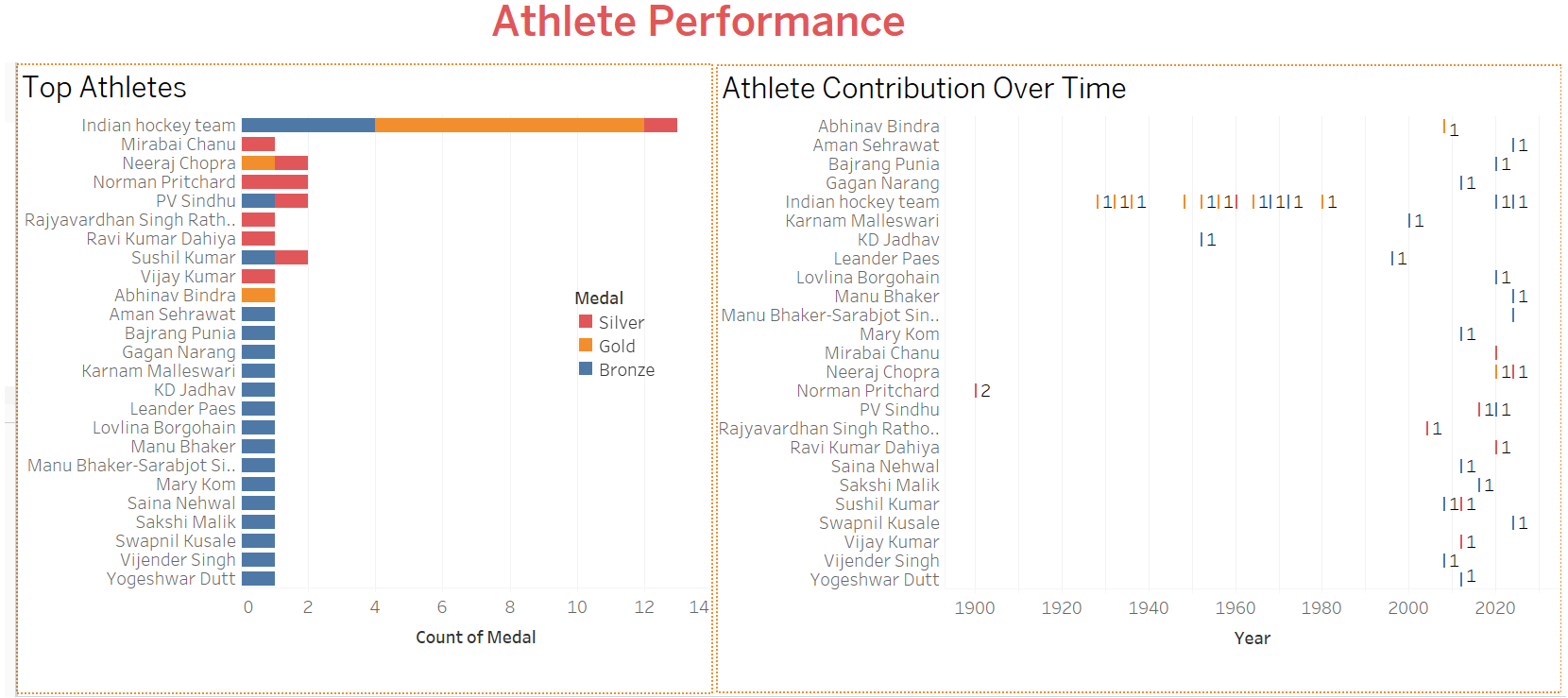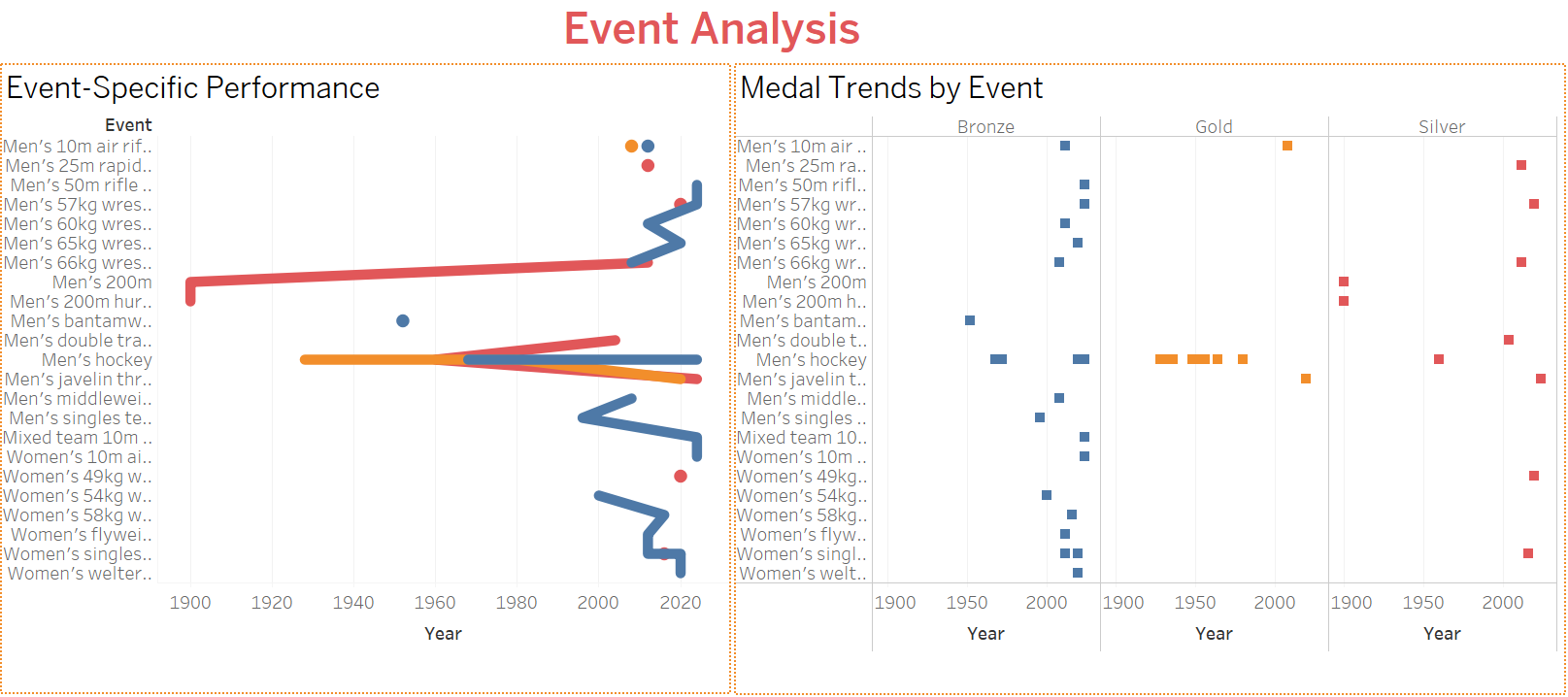Ijraset Journal For Research in Applied Science and Engineering Technology
- Home / Ijraset
- On This Page
- Abstract
- Introduction
- Conclusion
- References
- Copyright
Chronicles of Triumph: Data-Driven Insights into India\'s Olympic Success Journey (1900-2024)
Authors: Soorya Merin Tom
DOI Link: https://doi.org/10.22214/ijraset.2024.64091
Certificate: View Certificate
Abstract
This paper presents a comprehensive analysis of India\'s Olympic performance from 1900 to 2024, focusing on trends in ranking, athlete contributions, and event-specific achievements. By leveraging historical data and advanced visual analytics, we trace the evolution of India\'s Olympic journey, highlighting key milestones and areas of significant improvement. The study categorizes the data into four major sections: Ranking Analysis, Athlete Performance, Event Analysis, and Olympic Edition Comparison. Our findings reveal a dynamic progression in India\'s rankings, with notable contributions from individual athletes and a marked shift in performance across different events over the decades. The paper concludes with a discussion on comparative analysis, limitations, and recommendations, providing valuable insights for future strategic planning to enhance India\'s standing in the global Olympic arena.
Introduction
I. INTRODUCTION
The Olympic Games are the world's foremost sports competition, drawing participation from nations across the globe and embodying the spirit of excellence, competition, and unity. For India, the journey at the Olympics has been a story of perseverance, growth, and evolving sporting prowess. From its first appearance in 1900 to its most recent participation in 2024, India's Olympic history is marked by significant milestones and moments of triumph, reflecting the nation's broader socio-economic and cultural transformations [1]. India’s participation in the Olympics began modestly, with a few sporadic successes, particularly in field hockey, where the nation dominated for several decades. However, the landscape of Indian sports has undergone considerable changes over the last century. The post-2000 era, in particular, has seen a resurgence in India's Olympic performance, driven by a more structured approach to athlete development, increased government support, and a growing sports culture within the country [2]. This paper aims to provide a comprehensive analysis of India’s Olympic performance from 1900 to 2024, focusing on various aspects such as overall rankings, individual athlete contributions, event-specific performances, and the evolution of the nation’s Olympic strategy. By examining historical data and employing advanced visual analytics, we seek to uncover trends, identify key drivers of success, and offer insights that can inform future strategies to enhance India’s standing in the global Olympic arena [3].
As India continues to strive for excellence in sports, understanding the factors that have contributed to its Olympic successes and setbacks becomes crucial. This research not only chronicles the nation’s achievements but also serves as a roadmap for future endeavors, highlighting areas of potential growth and the strategic importance of sustained investment in sports [4].
II. LITERATURE REVIEW
The Olympic Games, since their modern inception in 1896, have evolved into the world’s most prestigious sporting event, characterized by diverse participation and a continually expanding program of events. India’s engagement with the Olympics, which began in 1900 with Norman Pritchard’s silver medals in athletics, presents a unique case study of a nation’s fluctuating fortunes on the global sports stage [5]. Early on, India’s Olympic participation was sporadic, reflecting the lack of an organized sports infrastructure and limited awareness about international competitions. Notably, India did not compete in the 1904 and 1908 Olympics, underscoring the challenges faced by the country in mobilizing athletes for international events during that period [6].
A significant aspect of India’s Olympic history is its unparalleled success in field hockey. From 1928 to 1956, India won six consecutive gold medals, a feat that established the nation as a dominant force in this sport. This era of hockey supremacy is often highlighted in the literature as a golden period for Indian sports, driven by a combination of skilled players, strategic prowess, and national pride [7]. However, the decline in India’s hockey fortunes post-1960, attributed to changes in the game’s dynamics—such as the introduction of synthetic surfaces and increased competition from other nations—marks a turning point in India’s Olympic narrative [8].
India’s Olympic participation was interrupted during the World War II years, with the 1940 Tokyo and 1944 London Olympics being canceled due to the global conflict. These cancellations disrupted the momentum India had built in the pre-war years, particularly in hockey. The literature notes that the war years were also a time of significant political upheaval in India, as the country was in the throes of its independence movement, which further affected its sporting activities [6].
The 1980 Moscow Olympics also stand out in India’s Olympic history, as the Games were heavily impacted by a boycott led by the United States to protest the Soviet invasion of Afghanistan. India chose to participate, and this year marked its last gold medal in field hockey, symbolizing both a high point and the beginning of a long period of decline in the sport [7]. The interplay between international politics and sports, as exemplified by the 1980 Olympics, is a recurring theme in the literature, highlighting how external factors often influence a nation’s sports policies and performances.
In the post-1980 period, India’s Olympic performance witnessed a decline, particularly in traditional strongholds like hockey. However, the late 1990s and early 2000s saw a resurgence in other sports, such as shooting, wrestling, and badminton. This resurgence is linked to broader socio-economic changes in India, including economic liberalization and increased investment in sports infrastructure [8]. Government initiatives, such as the establishment of the Sports Authority of India (SAI) and various athlete support programs, have been pivotal in nurturing new talent and improving India’s medal prospects. Moreover, the rise of private sports academies and corporate sponsorship has played a significant role in the development of athletes who have succeeded in international arenas [4].
Despite these developments, there remains a gap in the literature regarding a comprehensive analysis of India’s Olympic performance over the decades. While there are detailed studies on specific sports and individual athletes, a holistic view that integrates these elements into a broader narrative of India’s Olympic journey is lacking. This paper seeks to address this gap by providing a data-driven analysis of India’s performance from 1900 to 2024, offering insights into the trends, challenges, and successes that have shaped the nation’s Olympic history [5].
III. METHODS
The methodology of this research is structured to provide a thorough analysis of India's Olympic performance from 1900 to 2024, leveraging historical data and modern analytical techniques. This section outlines the steps taken to collect, process, analyze, and visualize the data, ensuring a robust and comprehensive understanding of the factors contributing to India's Olympic journey.
A. Data Collection
The first step in this research involved the collection of comprehensive data on India’s Olympic participation. Data was sourced from official Olympic records, sports databases, historical archives, and other reliable sources [6]. The dataset includes variables such as the year of participation, overall rank, athlete names, types of medals won (gold, silver, bronze), event names, and the edition of the Olympics (summer/winter). This dataset encompasses a wide temporal range, covering all Olympic Games from 1900 to 2024, ensuring a holistic view of India’s Olympic performance over time.
B. Data Processing
Once collected, the data underwent a rigorous cleaning and preprocessing phase to ensure its accuracy and consistency. This involved handling missing values, standardizing the naming conventions for athletes and events, and correcting any inconsistencies in the records [7]. Additionally, the data was categorized into key themes such as overall ranking trends, individual athlete performance, event-specific results, and Olympic edition comparisons. This categorization facilitated a more organized and focused analysis.
C. Data Analysis
In the data analysis phase, we employed various statistical and analytical techniques to interpret the dataset and uncover meaningful insights into India's Olympic performance [8]. The analysis began with identifying trends in India's overall ranking over time, highlighting periods of significant improvement or decline. We examined the performance of individual athletes by analyzing medal counts and their impact on the country's standings, focusing on sports with notable contributions, such as shooting, wrestling, and weightlifting. Event-specific analysis was conducted to evaluate India’s performance across different sports disciplines, revealing shifts from traditional team sports like hockey to individual sports. Additionally, a comparative analysis across different Olympic editions was performed to understand variations in performance and identify factors contributing to India's successes and challenges.
D. Visualization
In the visualization phase, Tableau was employed to craft a series of interactive dashboards, graphs, and charts that translate complex data into intuitive and accessible formats [8]. These visualization tools enable a detailed exploration of India's Olympic journey, presenting the data clearly and offering valuable insights into performance patterns.
IV. RESULTS
The results, as illustrated in the four key dashboards, provide a comprehensive view of India's Olympic performance from 1900 to 2024:
A. Ranking Analysis
The "Ranking Analysis" dashboard reveals a decline in overall performance rankings over time, especially since the 1980s, with a significant drop after the year 2000, suggesting challenges in maintaining competitive standings. The event-specific analysis shows consistent success in certain disciplines, like shooting and wrestling, while highlighting weaker performances in events such as hurdles and boxing categories. The distribution of medals over the years underscores shifting strengths and weaknesses, indicating areas for strategic focus to enhance future performances and regain competitive excellence.

FIG. 1. Ranking Analysis: Figure 1 displays the trend in India's overall Olympic rankings from 1900 to 2024. It illustrates periods of notable improvement and decline in rankings, highlighting the challenges faced in maintaining competitive standings, especially post-2000.
B. Athlete Performance
The "Athlete Performance" dashboard highlights the top-performing athletes and their contributions to medal achievements over time. The "Top Athletes" chart showcases individual athletes who have significantly impacted India's medal count, including those with multiple medals across various Olympics. The "Athlete Contribution Over Time" chart displays the distribution of medals by individual athletes across different years, indicating the consistent contribution of some athletes and teams in various Olympic events. This analysis reflects the significant impact of both team and individual performances on overall success, showcasing standout athletes and their contributions to the country's sports achievements over the years.

FIG. 2. Athlete Performance: Figure 2 illustrates the contributions of top-performing athletes to India's Olympic success, highlighting the impact of both individual athletes and teams in various events over time.
C. Event Analysis
The "Event Analysis" dashboard offers an in-depth examination of India's Olympic performance across various events from 1900 to 2024, highlighting consistent success in sports like shooting, wrestling, and hockey. The analysis shows that hockey, historically one of India's strongest sports, has contributed significantly to the country's medal tally, particularly in the early and mid-20th century. The analysis reveals key trends in event-specific performances, showing consistent success in disciplines like shooting and wrestling while highlighting challenges in events such as hurdles and boxing. The dashboard also presents medal trends by event, emphasizing periods of significant medal achievements, particularly in shooting and wrestling, while illustrating weaker performances in other categories. This event-centric view provides valuable insights into India's shifting strengths and strategic opportunities for enhancing future Olympic outcomes, aligning with the overall findings of a decline in performance rankings post-1980s, but with standout contributions from top athletes in recent years.
 FIG. 3. Event Analysis: Figure 3 provides a detailed examination of India’s Olympic performance across various sports disciplines, highlighting consistent successes and challenges in different events over time.
FIG. 3. Event Analysis: Figure 3 provides a detailed examination of India’s Olympic performance across various sports disciplines, highlighting consistent successes and challenges in different events over time.
D. Olympic Edition Comparison
The "Olympic Edition Comparison" dashboard provides an overview of performance and rankings across different Olympic editions from 1900 to 2024. The "Performance per Olympics" chart illustrates the number and type of medals (Bronze, Silver, Gold) won in each Olympic edition, highlighting notable performances in London 2012 and Tokyo 2020, where the highest medal counts were achieved. The "Overall Rank per Olympics" chart shows the fluctuating ranks of the team across different Olympic editions, with rankings improving notably during some editions and declining in others. The trend demonstrates variable performance, with significant improvements in recent Olympics, indicating a progressive enhancement in competitiveness over time.

FIG. 4. Olympic Edition Comparison: Figure 4 compares India's performance and rankings across different Olympic editions, illustrating trends in medal counts and overall rankings over time.
Overall, these dashboards collectively provide a clear and detailed picture of India's Olympic journey, illustrating trends, achievements, and areas for potential growth.
V. DISCUSSION
The analysis of India's Olympic performance from 1900 to 2024 reveals significant trends and offers critical insights into the country's sporting journey [1]. The findings suggest that while India has achieved notable success in specific sports like hockey, shooting, and wrestling, there are consistent challenges in other events such as hurdles and boxing. These insights have important implications for both policy and practice, indicating a need for targeted investments in sports where India has historically excelled, as well as a strategic focus on improving performance in weaker areas [2]. The study also highlights the impact of individual athletes on overall performance, suggesting that enhanced athlete development programs could further bolster India's medal prospects. However, the research is limited by the availability of comprehensive data, particularly for earlier Olympic Games, which may affect the generalizability of the findings. Future research should aim to address these gaps and explore the socio-economic and infrastructural factors that influence India's Olympic success, thereby providing a more holistic understanding of the determinants of sporting excellence in the country [3].
Conclusion
The comprehensive analysis of India\'s Olympic performance from 1900 to 2024 underscores both the successes and challenges faced by the nation on the global sporting stage. India\'s dominance in sports like hockey, shooting, and wrestling highlights areas of historical strength, while the struggles in events such as hurdles and boxing point to opportunities for improvement. The study reveals the significant impact of individual athletes on India\'s overall medal tally, suggesting that continued investment in athlete development and targeted sports programs could enhance future Olympic outcomes. Despite the progress made, the research identifies limitations related to data availability and the need for a deeper exploration of the factors driving success. Moving forward, a strategic focus on bolstering weak areas, coupled with sustained support for successful sports, could play a crucial role in elevating India\'s standing in the Olympics and fostering a more robust sporting culture in the country [4].
References
[1] International Olympic Committee (IOC). (n.d.). Olympic Games Historical Data. Retrieved from https://www.olympic.org/ [2] Olympic Council of Asia. (2024). India’s Participation in the Olympic Games. Olympic Council of Asia Archives. [3] Sports Authority of India. (2022). Annual Report: India’s Performance in International Sports. New Delhi: Ministry of Youth Affairs and Sports. [4] Chakrabarty, B. (2010). The Golden Era of Indian Hockey: 1928-1956. Journal of Sports History, 37(3), 421-436. https://doi.org/10.5406/jsporthistory.37.3.0421 [5] Sen, S., & Sharma, R. (2018). The Evolution of Indian Athletics at the Olympics: A Historical Perspective. Journal of Olympic Studies, 5(2), 117-135. [6] Datta, A., & Bose, M. (2012). India\'s Olympic Medal Drought: An Analysis of Contributing Factors. International Journal of Sports Management and Marketing, 7(4), 304-319. https://doi.org/10.1504/IJSMM.2012.048529 [7] Gupta, R. (2021). The Impact of Economic Reforms on Indian Sports Performance. Asian Economic Review, 63(1), 89-112. [8] Shukla, P., & Malhotra, A. (2019). Private Sector Involvement in Indian Sports: A Case Study of Olympic Preparation. Journal of Sports Economics, 20(2), 172-190. https://doi.org/10.1177/1527002518765612
Copyright
Copyright © 2024 Soorya Merin Tom. This is an open access article distributed under the Creative Commons Attribution License, which permits unrestricted use, distribution, and reproduction in any medium, provided the original work is properly cited.

Download Paper
Paper Id : IJRASET64091
Publish Date : 2024-08-27
ISSN : 2321-9653
Publisher Name : IJRASET
DOI Link : Click Here
 Submit Paper Online
Submit Paper Online

